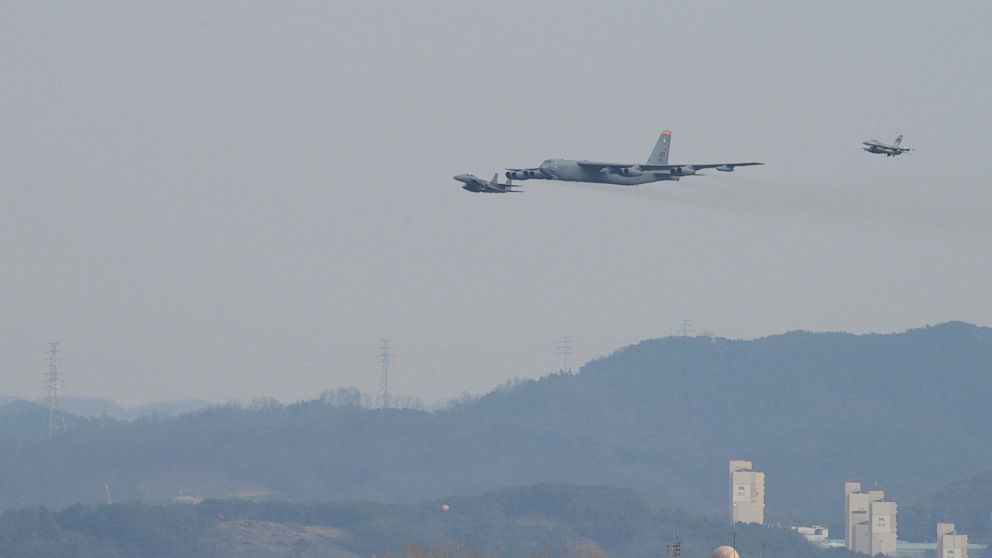U.S. B-52 Flyover of South Korea in Response to North Korean Nuclear Test
Flight Is Direct Response to North Korean Nuclear Test

— -- As a show of force in response to North Korea’s nuclear test earlier this week, the United States has flown a B-52 long range bomber to South Korea to conduct a low level flight over a U.S. military base 30 miles south of Seoul.
The U.S. conducted a similar flight in 2013 about a month after North Korea’s last nuclear test.
"A U.S. B-52 bomber from Andersen Air Force Base, Guam, conducted a low-level flight in the vicinity of Osan, South Korea, in response to a recent nuclear test by North Korea," said a statement from U.S. Pacific Command. "The B-52 was joined by Republic of Korea F-15 fighter aircraft and U.S. F-16 fighter aircraft."
After the mission was completed the bomber returned to its base in Guam.
"This was a demonstration of the ironclad U.S. commitment to our allies in South Korea, in Japan, and to the defense of the American homeland," said Adm. Harry B. Harris Jr., the commander of U.S. Pacific Command in the statement.
"North Korea's nuclear test is a blatant violation of its international obligations," Harris said. "U.S. joint military forces in the Indo-Asia-Pacific will continue to work with all of our regional allies and partners to maintain stability and security."
"The flight today demonstrates the strength and capabilities of the Alliance," said Gen. Curtis M. Scaparrotti, United Nations Command, Combined Forces Command, U.S. Forces Korea commander. "The close military cooperation between the United States and the Republic of Korea ensures we are ready to respond at any time to those who would threaten stability and security."
Since Monday's test Defense Secretary Ash Carter has twice phoned South Korean Defense Minister Han Min-koo to reaffirm the American security commitment to South Korea to coordinate possible responses to the North Korean test.
While North Korea has claimed that its test was a hydrogen bomb, the U.S. does not believe that is the case. The initial U.S. intelligence assessment "is not consistent with North Korean claims of a successful hydrogen bomb test," said Josh Earnest, White House Press Secretary on Wednesday.
A U.S. official has told ABC News that the yield from the North Korean test is believed to be in the single digits, much smaller than the yield that would have been produced by a hydrogen bomb.
To gather more information on the test the U.S. has sent a WC-135 aircraft known as "Constant Phoenix" to Japan to "sniff" for possible radioactive isotopes in the atmosphere. The gathered samples will be flown to the United States for analysis to determine what type of nuclear materials were used for the test. A U.S. official said samples from the first flight had not detected any radiation yet.
Asked at a Pentagon news conference Thursday, Pentagon Press Secretary Peter Cook said there were discussions about "additional steps that may or may not need to be taken in order to respond to the latest actions from the North Koreans." He later said that with 28,000 U.S. troops in South Korea, "every day is a show of force" when it comes to responding to North Korean provocations.
"The bilateral flight mission demonstrates the strength of the alliance between the United States and the Republic of Korea and the resolve of both nations to maintain stability and security on the Korean Peninsula," said the statement from U.S. Pacific Command.
In March, 2013 two B-52 bombers flew to South Korea during a long-planned joint annual exercise, however the bombers’ participation was added to the exercise as a response to a North Korean nuclear test the week before.




